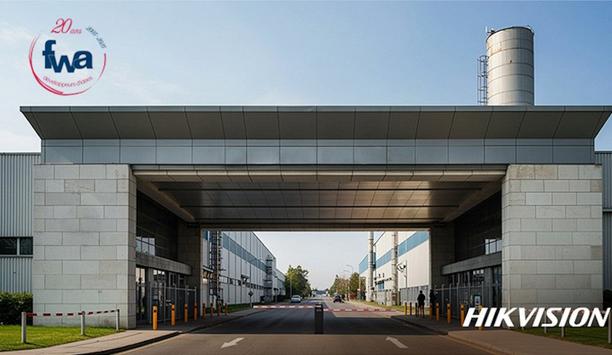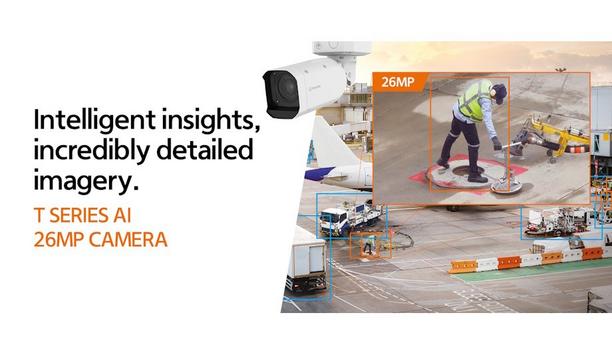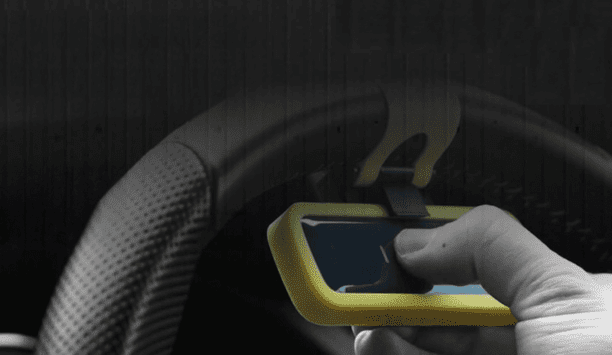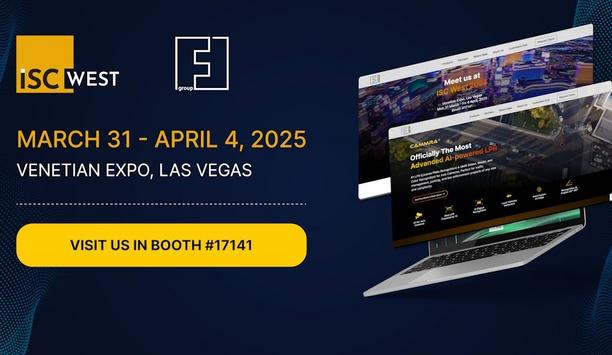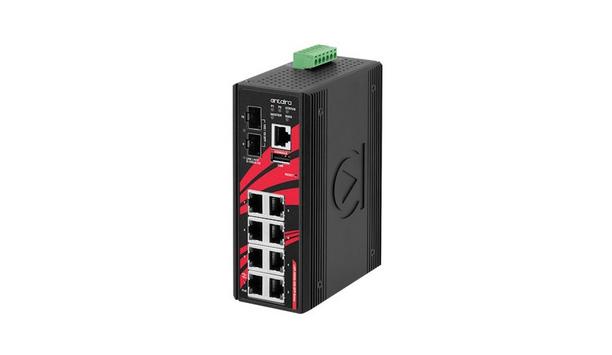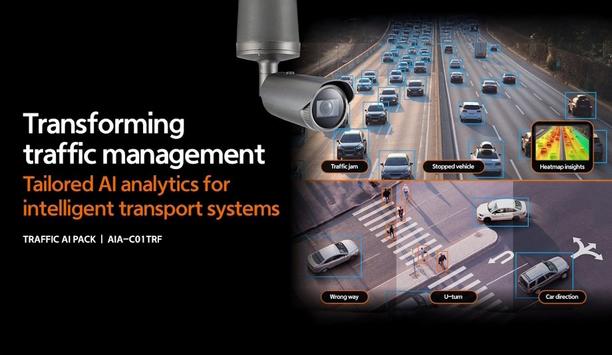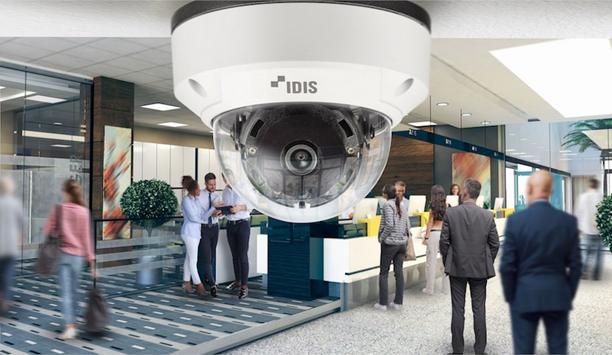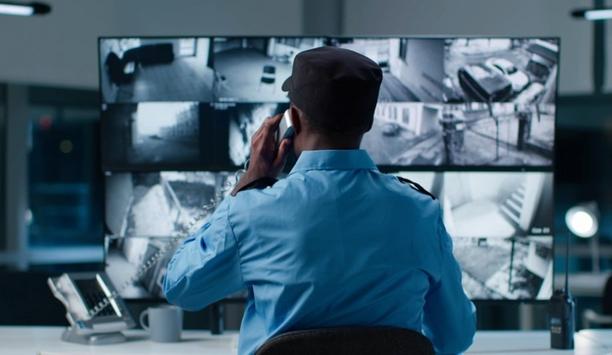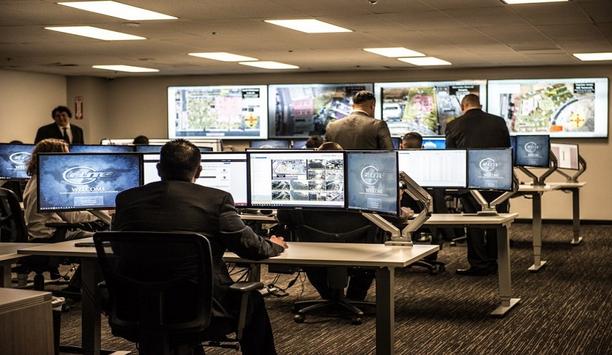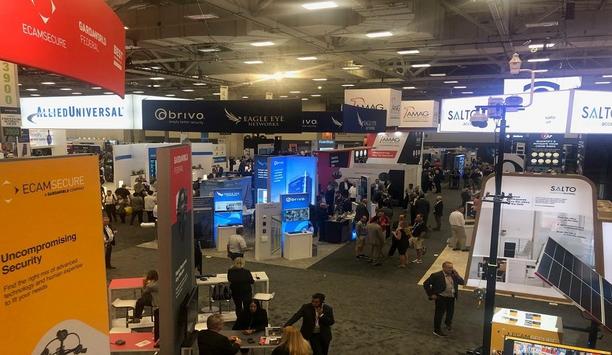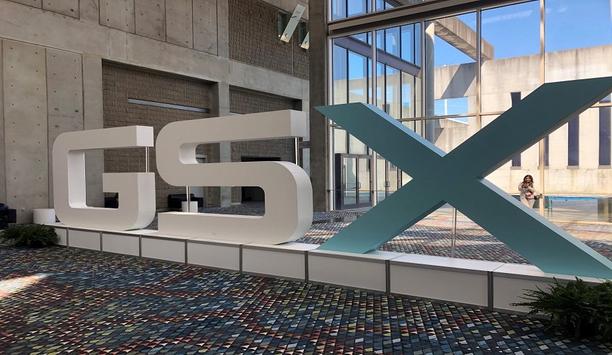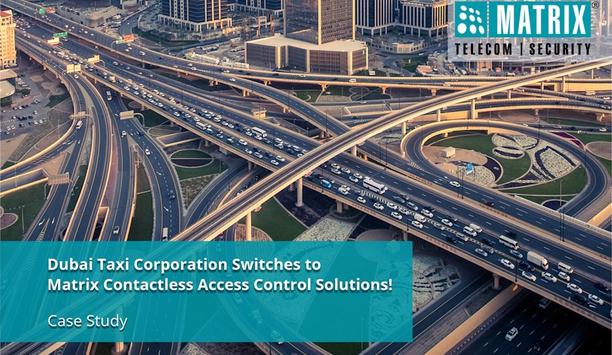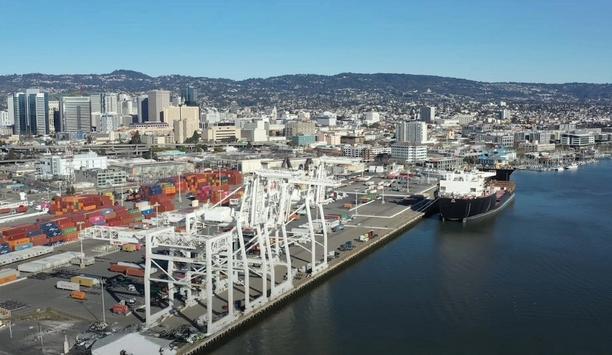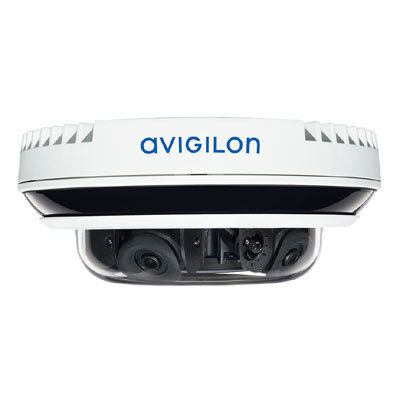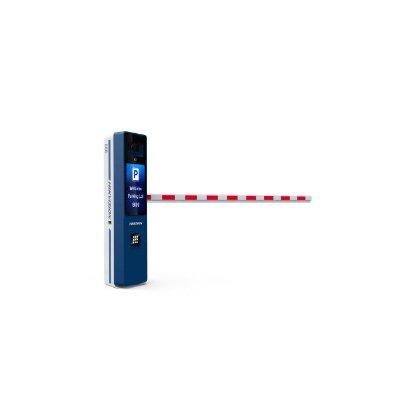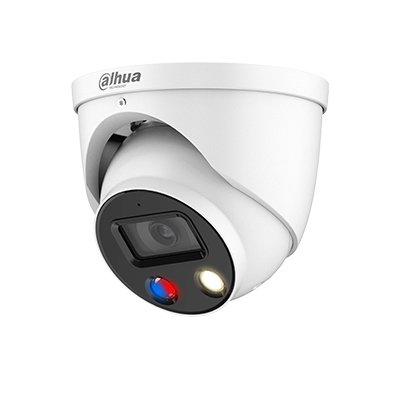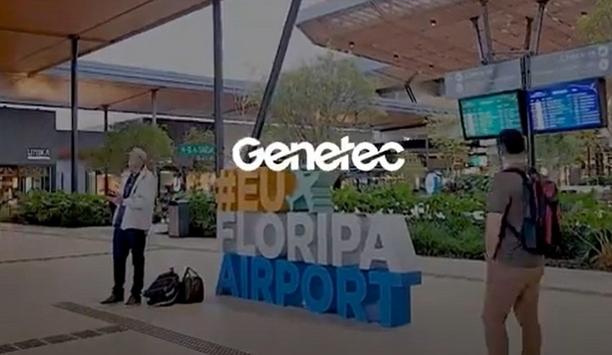Vehicle tracking
Commtact, a provider of advanced wireless communication solutions for defence, security forces, and robotic platforms, will showcase its latest innovation, the Micro Phoenix, at the DEFEA 2025 exhibition in Athens, Greece. As part of the company's portfolio of mission-critical communication systems, the Micro Phoenix delivers secure, resilient, and high-performance connectivity for land, air, and maritime platforms, in a compact, lighter-than-ever design. Commtact is also proud to announce its...
ISS (Intelligent Security Systems), a pioneering provider of video intelligence and data awareness solutions, is proud to announce that our SecurOS® UVSS (Under Vehicle Surveillance System) is now listed on GSA Advantage, an online purchasing platform for U.S. General Services Administration (GSA) Schedule contracts. This milestone simplifies procurement for federal agencies, and it also underscores the commitment to providing advanced video intelligence solutions to the government se...
Hikvision has collaborated with the French software developer, FWA. The partnership has enabled FWA to integrate Hikvision’s automatic number plate recognition (ANPR) licence plate detection technology into its DuckTheLine logistics queue management solution. DuckTheLine enables site managers to schedule when trucks should arrive, and to optimise their progress through the facility whilst they are on-site. Process of loading and unloading The alliance with Hikvision enables FWA to autom...
Nauto®, the pioneer in AI-powered safety and operations excellence for commercial vehicles, announced the results of a new third-party performance study conducted in December 2024 by The Virginia Tech Transportation Institute (VTTI), a globally recognized authority in transportation research. The study builds upon VTTI's original 2023 benchmark study, which tested safety systems across six distinct driving risk scenarios. Nauto excelled overall in both detectio...
The global touch and display industry is at a turning point, fuelled by AI advancements, technological breakthroughs, and shifting markets. How can businesses rise above the competition and secure future opportunities? C-Touch & Display Shenzhen returns, taking place October 28-30, 2025, at the Shenzhen World Exhibition & Convention Centre (Bao’an New Venue). This year’s event spotlights next-gen touch and display solutions alongside advanced semiconductor packaging, u...
Hanwha Vision, a pioneer in security and surveillance solutions, introduces the TNO-A26081, an ultra-high-resolution AI-powered camera designed to deliver unmatched imaging clarity and powerful analytical capabilities. With 26MP resolution at 30 frames per second, this camera captures every detail, making it ideal for large-area surveillance and high-security environments. Furthermore, its AI features ensure precise object detection, improved operational efficiency, and seamless integration in...
News
Pyronix announces new campaign offering a complimentary CarDefender inside every Enforcer Kit purchase, in promotion-labelled packs and while stocks last in distributors. This promotion will give installers immediate access to a free, award-winning peripheral when they buy one of our best-selling products. Next-gen auto safety The device’s inbuilt shock/tilt sensor offers three configurable detection modesThe CarDefender is an innovative wireless peripheral offering protection against car and vehicle theft. The device’s inbuilt shock/tilt sensor offers three configurable detection modes which ensures any unwanted interference with a vehicle will trigger the home’s alarm, when connected to and in range of the Pyronix security system. This multi-award-winning peripheral (including Innovative Security Project of the Year at the British Security Awards) is a novel device that may be unfamiliar to many homeowners, so the free product offering is a great way to introduce the CarDefender into the installer’s sales conversations with customers. Smart theft protection “We developed the CarDefender because we saw an opportunity to help combat the rising trend of vehicle theft, especially with the recent emergence of wireless key theft,” commented Laurence Kenny, Product Director at Pyronix. “We have created an innovative product to tackle theft of all vehicles, from cars to vans and bikes/e-bikes, and even farming equipment.” Wireless security solutions The kits are an ideal way to begin building an alarm system, alongside a range of wireless peripherals The free CarDefender is inside labelled, promotional boxes of our range of Enforcer Kits. This includes Enforcer Kits 1-6 as well as both of the Enforcer Arming Station Kits – the whole range. The kits are an ideal way to begin building an alarm system and come with our flagship wireless panel, the Enforcer V11, alongside a range of wireless peripherals including shocks, contacts, PIR detectors and Deltabell modules, depending on which kit is purchased. The Enforcer V11 is also compatible with our free smartphone app, HomeControl2.0, meaning that homeowners are able to control the entire Pyronix ecosystem from anywhere. Cloud-powered growth For installers, app connectivity also introduces an upselling opportunity for cloud subscriptions, which can also result in recurring revenue benefits. An Enforcer Kit creates the core of a security system which can then be added to when tailoring an install to the specific needs of the customer, and now installers can include a free CarDefender too.
FF Group, a pioneer in AI licence plate recognition on the edge, has chosen ISC West 2025 as the platform to introduce its world’s fastest on-camera licence plate and vehicle recognition software to the North American market. CAMMRA AI™ from FF Group brings next-level licence plate recognition (LPR), leveraging advanced AI technology onboard a camera to serve modern traffic management, smart city and law enforcement markets. FF Group will exhibit at Booth #17141 at ISC West, to be held April 2-4 in Las Vegas. Safety and management solutions FF Group is a market pioneer in Europe, the Middle East, and Australia with its AI A pioneer of LPR on the edge more than a decade ago, FF Group is a market pioneer in Europe, the Middle East, and Australia with its AI-powered road safety and management solutions. With its ISC West debut of CAMMRA AI™, FF Group expands its expertise to the broader North American market, where it is already in use in places such as Newport, R.I, a seaside community known for its high volume of traffic and parking issues. CAMMRA AI LPR software with cameras The city is using the CAMMRA AI LPR software with cameras from Axis Communications to recognise vehicle details, such as make, model, and plate, and merge the vehicle data with speed from Axis Radar technology. The city of Newport is also using CAMMRA AI in conjunction with acoustic monitors from Sorama to detect loud vehicles, making it one of the first solutions of its kind in the world. LPR cameras and functions CAMMRA AI™ goes beyond simple licence plate recognition and optical character recognition “We are very pleased to introduce to the U.S. market our dedicated approach to AI on the edge, which dramatically improves LPR functions by increasing the accuracy of recognition,” said Alex Osypov, chief executive officer of FF Group. “This allows LPR cameras using our software to function much more effectively in different environmental conditions, reduces installation and infrastructure costs and offers greater reliability to the LPR solution.” CAMMRA AI LPR and MMCR Powered by five Convolutional Neural Networks (CNNs), CAMMRA AI brings LPR and Make Model Colour Recognition (MMCR) into a single, unified application for sophisticated tracking and analysis of vehicle behaviour. This cutting-edge software ensures unparalleled accuracy and speed, processing vehicle data directly at the camera edge, reducing reliance on server or cloud-based resources and providing more efficient, scalable results. Unlike traditional LPR solutions, CAMMRA AI™ goes beyond simple licence plate recognition and optical character recognition. CAMMRA AI is seamlessly embedded in Axis cameras.
Power over Ethernet (PoE) switches have fundamentally transformed how devices are powered and connected to industrial networks. By transmitting both power and data through a single Ethernet cable, industrial PoE switches enable the deployment of Powered Devices (PD), such as IP cameras, wireless access points, VoIP phones, and sensors. New generation of PoE switches New generation of low-voltage PoE switches able to operate on input voltages below 48VDC Standard PoE Ethernet switches supply PDs with clean, stable DC power compliant with the IEEE’s 802.3af/at/bt PoE specifications. In order to do this, they usually require 48VDC (Direct Current Voltage) input, and are unable to properly supply PoE to devices in settings where this voltage is not accessible. This article explores a new generation of low-voltage PoE switches able to operate on input voltages below 48VDC. Internal DC-to-DC power-boosting technology enables these switches to convert 12-36VDC input to 48-56VDC output, ensuring seamless power delivery for PDs in compliance with IEEE 802.3 PoE standards. IEEE specifies 48VDC input on devices Due to its stability, virtually all communication devices utilise direct current (DC) sourced from a power supply, converting alternating current (AC) into DC or a DC battery. IEEE specified 48VDC in its PoE standards because it balances efficient power transmission, voltage drop considerations over long Ethernet cable runs, and electrical safety thresholds. IEEE’s original PoE standard PoE operates within a flexible voltage range rather than a fixed 48VDC While many PoE devices can operate on battery power, the vast majority of enterprise and industrial PoE networks derive power from AC-to-DC power supplies converting grid electricity. PoE operates within a flexible voltage range rather than a fixed 48VDC. The IEEE’s original PoE standard, 802.3af, along with subsequent standards 802.3at and 802.bt, specify a voltage range requirement of 44 to 57 volts. Power standard PoE switches Industrial networks continuously change and expand into new areas, unlocking opportunities even in locations without 48VDC input to power standard PoE switches. Low voltage input switches represent an innovative new solution, eliminating the need for complex setups like connecting four 12V batteries in series to achieve 48VDC. By simplifying power requirements, low voltage input Ethernet switches save space, reduce complexity, and enhance reliability by removing the need for additional voltage converters for lower-voltage devices. Below are some applications where low-voltage PoE switches excel, particularly in remote sites without readily available power outlets. Smart buses These vehicles are networked to improve transportation efficiency and the passenger experience. Smart buses can be frequently equipped with IP cameras, WAPs, GPS, and VoIP, yet have only DC12V input for a PoE switch to draw power. Similar power challenges arise in RVs, mobile command centres, trucks, and ships. Remote sites Off-grid industrial sites use solar-powered battery systems featuring DC12V, DC18V, and DC36V inputs Off-grid industrial sites use solar-powered battery systems featuring DC12V, DC18V, and DC36V inputs. Depending on the size of the panel and the sunlight conditions, different types of high-capacity batteries can be charged to power a low-voltage industrial PoE switch, greatly simplifying connectivity for multiple PDs. These PDs can include standalone roadside devices, access control/VoIP, agricultural monitoring, surveillance trailers, and Intelligent Transportation Systems. Besides solar, batteries can be charged by a backup generator or connected to the grid during off-peak hours, when available. Though far less common, wind, hydroelectrical, and geothermal power are power options. Factory automation Although these electrical systems can range from 12VDC to 36VDC, the de facto voltage for industrial automation and control systems is 24VDC. Relays, industrial sensors, actuators, and PLCs use 24VDC, for instance. A low-voltage PoE switch will operate on various 24VDC power supplies in industrial automation systems. The low voltage PoE switch will power network devices directly from a properly specified 24VDC power supply without needing a separate high-voltage wall outlet. Mobile trailers Solar-powered mobile security trailers offer a key for where reducing the use of long cables improves safety Solar-powered mobile security trailers allow for quick deployment in various scenarios, such as construction sites, live events, parking lots, schools, and general crowd control. Trailers provide a security presence by being equipped with multiple IP cameras, speakers, wireless radios, lights, and other hardware to identify, find, and deter criminals and capture incidents 24/7, day or night. Solar-powered mobile security trailers offer a solution for where reducing the use of long electrical cables improves safety. In these situations, a low-voltage PoE switch with an internal DC boost is required to convert 12-36VDC input into the necessary 48-56VDC PoE output for connected PDs. Antaira power boost Antaira's "power boost" technology utilises the switch's integrated circuitry, typically a boost converter, to efficiently store energy in an inductor during the switch-on phase and release it during the switch-off phase. This process results in a higher output voltage than the input, ensuring reliable power delivery. This way, PDs operate on a standard 48VDC PoE output even when the industrial type of switch is supplied with a lower voltage input. It also eliminates the need for a separate step-up transformer and, in turn, saves space in an enclosure using only one device.
Hanwha Vision, a pioneer in video surveillance and security solutions, unveils its Traffic AI Pack – AIA-C01TRF, a cutting-edge solution designed to transform traffic monitoring and management by empowering operators with sophisticated detection capabilities to enhance road safety, optimise traffic flow, and improve overall efficiency. Available with selected Hanwha Vision’s P series AI cameras, the solution can detect, classify, and track vehicles in real-time. By identifying various vehicle types—cars, trucks, buses, motorcycles, and bicycles—the AI pack provides traffic operators with crucial road usage and traffic flow data to inform transport planning and decision-making. Overall road safety AI pack can also detect and alert to stopped vehicles, mitigating the risk of further accidents Instant alerts for wrong-way driving and illegal U-turns enable authorities to respond promptly to reduce the risk of incidents. The AI pack can also detect and alert to stopped vehicles, mitigating the risk of further accidents and enhancing overall road safety. Pedestrian detection ensures safety at crossings with instant alerts sent for unexpected people in the road and possible vehicle/person collisions. Advanced features for comprehensive traffic management The solution offers advanced features for comprehensive traffic management such as vehicle queue analysis and multi-lane counting by vehicle type. This allows operators to efficiently monitor intersections and analyse movement patterns to improve traffic flow. Vehicle queuing data and traffic counts can inform proactive actions including opening additional lanes, redirecting traffic, or altering signal timing. Insights for optimising urban planning AI pack includes data visualisation for vehicle counting and heatmaps, to mean traffic zones In addition, the system detects vehicle speed, up to 25mph/40kph, and monitors traffic density with users able to set thresholds for specific areas, issuing alerts when congestion or delays occur. Complementing its detection capabilities, the AI pack includes data visualisation for vehicle counting and heatmaps, to represent high-traffic zones and peak times. This provides traffic operators with actionable insights for optimising urban planning and road management. Integrating features John Lutz Boorman, Head of Product and Marketing at Hanwha Vision Europe, said, “The pack stands out as a comprehensive traffic solution that ensures smoother and safer roads for all." "By seamlessly integrating features such as vehicle and pedestrian counting, stopped vehicle detection, and traffic jam monitoring, operators are empowered with the insights they need for proactive management and rapid responses.” Key features of the Hanwha Vision Traffic AI pack Detect and classify vehicles (car, truck, bus, motorcycle, bicycle) Wrong-way vehicle and illegal U-turn detection Vehicle speed detection (25mph/40kph) Traffic jam and stopped vehicle detection Pedestrian detection Vehicle counting Vehicle turning movement counts Vehicle queue analysis Vehicle detection heatmap
IDIS Americas will have a bigger presence at ISC West this year (April 2025, Las Vegas, booth #8037) with an expanded range of high-quality, Korean and U.S.-origin technologies and its most comprehensive lineup of new products and technologies to bolster its end-to-end, AI-enhanced video surveillance solutions. A major draw for visitors will be IDIS’s new Edge AI Camera Plus range which offers users a host of tools to improve real-time surveillance operations and footage search-and-playback. Updated IDLA Pro functions New range features updated IDLA Pro functions that drive even greater operational efficiency The new range features updated IDLA Pro functions that drive even greater operational efficiency for busy security teams, with on-the-edge analytics capabilities including crowd detection, abandoned and removed object detection, fall detection, and violence detection, enabling more proactive security responses. It also features the new A-Cut function, allowing searches by key attributes. Visitors to ISC West will get an exclusive first look at IDIS’s patented Live Privacy Masking technology, which allows more accurate, reliable, and responsive real-time video surveillance, while protecting individuals’ identities. Deep learning technology This important innovation uses deep learning technology to improve the quality and usability of privacy masked footage to assist live surveillance operations. Overcoming the limitations of existing technologies, this is an ideal solution for applications with privacy compliance concerns, from mass transit to public institutions. I-Mobile integrates AI-powered video surveillance IDIS will be showcasing a strong lineup of solutions for the education (K12) sector The I-Mobile solution for mass transit applications builds on IDIS’s 20-year track record pioneering video surveillance technology for transit services including private and public bus fleets. I-Mobile integrates robust AI-powered video surveillance and GPS with wider fleet management systems to optimise security, safety, operational agility, and profitability. IDIS will be showcasing a strong lineup of solutions for the education (K12) sector, including robust video intercoms for secure and efficient access control, and weapons detection surveillance powered by IDIS Vaidio AI analytics, a powerful AI solution which offers a broad range of highly accurate automated detection and alert functions. Latest AI functionality For retail applications, IDIS will showcase its comprehensive choice of video technologies proven to reduce losses and boost profitability. With the latest AI functionality, IDIS end-to-end solutions include the widest choice of cameras, recorders, and VMS to help retailers of all sizes – from high-end and luxury stores to grocery chains - enhance operational efficiency and improve their customer experience, while helping to ensure security. Range of NDAA-TAA compliant video solutions IDIS showcases a full range of NDAA-TAA compliant video solutions that meet FIPS 140-3 compliance Enabling easier systems integration, IDIS HDMI Encoders allow data from point-of-sale to be overlayed on high resolution video for ease of investigation, while log collectors can feed retail video analytics data into wider ERP and inventory management systems. For U.S. government applications, IDIS will showcase a full range of NDAA-TAA compliant video solutions that also meet FIPS 140-3 compliance. For the banking sector, IDIS’s best-selling video solutions for ATMs will be on display, including specialty cameras that integrate with IDIS Solution Suite VMS and are designed for robust performance in isolated and physically challenging environments. IDIS’s Hybrid TVR recorder (TR-2604) supports analog and IP cameras, featuring a compact design to fit inside ATMs. 5MP IR PoE Extender Cameras In the logistics sector, IDIS Americas has already made a significant impact with its award-winning fisheye cameras which provide cost-effective 180-degree surveillance of loading bays and storage areas without blind spots. At ISC West, the company will also showcase the 5MP IR PoE Extender Cameras that give easier, faster options for system expansion, leveraging existing wiring and eliminating the need for new cabling from the NVR or switch. IDIS Solution Suite VMS IDIS booth will feature hands-on Experience Zones giving visitors the chance to try out IDIS NVRs This year, the IDIS booth will feature hands-on Experience Zones giving visitors the chance to try out IDIS NVRs and receive valuable experience with the feature-rich, user-friendly IDIS Solution Suite VMS. Additionally, IDIS Americas is launching a new Partner Program, designed to empower systems integrators with exclusive advantages. Members will gain priority support, tailored training, and access to cutting-edge security solutions that drive growth and success. Advanced lineup of end-to-end video solutions The program ensures integrators have the resources and expertise needed to deliver seamless, high-performance deployments across a range of industries. “This year at ISC West, IDIS Americas is making a bigger impact than ever before,” said Scott Switzer, CEO of IDIS Americas. “We’re bringing our most advanced lineup of end-to-end video solutions, packed with game-changing AI, smarter integrations, and industry-first innovations." IDIS Vaidio AI analytics The program ensures integrators have the help and expertise needed to deliver seamless solutions Switzer added: "From our Edge AI Camera Plus range and next-gen IDIS Vaidio AI analytics to cutting-edge privacy masking and seamless enterprise integrations, we’re delivering the technology our customers need to enhance their security, boost efficiency, and help drive profitability." "We’re also investing in our commitment to integrators with the launch of our new Partner Program giving them the tools, training, and support to win more business and deliver outstanding results. This is the year to experience IDIS like never before, and we are excited to show ISC West attendees what’s next.” How IDIS solutions simplify installation and operation Visitors to the IDIS booth at ISC West can expect an unforgettable experience, gaining firsthand insight into the power of IDIS end-to-end video solutions. They’ll connect with the experts behind the technology, explore industry-pioneering innovations that deliver unmatched recording stability and reduced storage burdens, and discover tools for more proactive, real-time monitoring. Attendees will also see how IDIS solutions simplify installation and daily operation, lower maintenance and operating costs, and enhance cybersecurity with proprietary protocols and certificate-based authentication.
Robotic Assistance Devices, Inc. (RAD), a subsidiary of Artificial Intelligence Technology Solutions, Inc., has unveiled ROAMEO™ Generation 4 (Gen 4), believed to be the most advanced commercial autonomous security patrol mobile robot ever created. Built to outmatch traditional security guard patrols in every way, ROAMEO Gen 4 combines AI-powered intelligence, engagement by SARA™, 360-degree situational awareness, advanced safety features and real-time threat detection to eliminate blind spots, reduce costs, and deliver a new era of proactive security. Delivering unmatched performance “The days of inefficient, unreliable, and costly security patrols are over,” said Steve Reinharz, CEO/CTO of AITX and RAD. “ROAMEO Gen 4 is not just an improvement, it is a complete reimagination of how security patrols operate. The intelligence packed into this unit now offers features such as ‘escort me’ and ‘find my car’ to ensure it can outperform legacy solutions in almost every way. This is the security solution of the future, delivering unmatched performance and cost savings today.” ROAMEO (Rugged Observation Assistance Mobile Electronic Officer) Gen 4 is more than an upgrade, it is a transformation. Key features and advantages include: Full AI-Driven Autonomy – Operates 24/7 without breaks, distractions, or fatigue, continuously patrolling for up to 16 hours per charge. Customer Engagement Features – ROAMEO Gen 4 goes beyond security by offering interactive services such as ‘Escort Me’ and ‘Find My Car,’ ensuring a safer and more user-friendly experience for employees, visitors, and customers. Advanced Threat Detection – Uses AI-powered monitoring with LiDAR and visual analytics to detect, track, and analyse potential threats in real-time. Unmatched Navigation & Safety – Equipped with GPS-denied navigation, five solid-state 3D LiDARs, obstacle avoidance, emergency stop features, and predictive path planning. Web-Based Command & Control – Security teams can direct ROAMEO Gen 4 remotely via an intuitive interface, instantly adjusting patrol routes and receiving live alerts. Cost-Effective Security Solution – Eliminates expenses associated with wages, overtime, benefits, and liability insurance while providing a more effective security presence. Robust AI-driven detection system ROAMEO Gen 4 ensures no security gap is left unmonitored With a top patrol speed of 10mph, a 30-mile range per charge, and a robust AI-driven detection system, ROAMEO Gen 4 ensures no security gap is left unmonitored. “The numbers tell a clear story,” added Reinharz. “Tens of thousands of security guards are performing patrol functions that can be enhanced or replaced by ROAMEO Gen 4. The industry is facing increasing demands for coverage, yet labor costs and workforce shortages remain persistent challenges. ROAMEO offers an autonomous, scalable alternative that improves efficiency while reallocating human resources to more strategic roles. As demand for security continues to rise, AI-driven solutions like ROAMEO will redefine the future of patrol and surveillance.” Key deployment areas Organisations across multiple sectors are lining up to integrate ROAMEO Gen 4 into their operations. Key deployment areas include: Industrial Facilities & Warehouses – AI-driven perimeter security and real-time threat deterrence. University & Corporate Campuses – Strengthens security presence and deters vandalism. Automotive Storage & Dealership Lots – Protects valuable inventory from theft and tampering. Healthcare Campuses & Parking Structures – Creates safer environments for employees and visitors. Corporate Headquarters & Data Centers – Provides unmatched surveillance for critical infrastructure. Large-scale deployments “ROAMEO is central to our strategy to redefine security through intelligent automation,” concluded Reinharz. “Beyond innovation, it will be a revenue driver and a category leader in autonomous security. Market demand confirms the need for large-scale deployments, and each ROAMEO unit represents long-term recurring revenue for the Company. Even with 25 deployments, the financial impact will be significant. At 100 units, projected by the end of 2026, ROAMEO will be a major force in our growth and profitability. As we scale into the hundreds, it will reinforce our market leadership and accelerate our path to sustained success.” Outdated security models “This is more than just an advancement, it’s an industry shift,” said Mark Folmer, CPP, PSP, President of RAD. "We are on a mission to redefine security by delivering AI-powered, autonomous solutions that enhance safety, improve efficiency, and drive cost savings. ROAMEO Gen 4 is not waiting for the future, it is the future.” Pre-orders are now open with production ramping up starting in the summer, and live demonstrations are being scheduled. ROAMEO Gen 4 will be on display at ISC West in Las Vegas from March 31 through April 4 in RAD’s booth #21131. Security professionals and facility managers must decide: Will you lead with innovation, or stay behind with outdated security models? Mobile robotic solutions Each Fortune 500 client has the potential of making numerous reorders over time AITX, through its subsidiary, Robotic Assistance Devices, Inc. (RAD), is redefining the nearly $50 billion (US) security and guarding services industry[ii] through its broad lineup of innovative, AI-driven Solutions-as-a-Service business model. RAD solutions are specifically designed to provide cost savings to businesses of between 35%-80% when compared to the industry’s existing and costly manned security guarding and monitoring model. RAD delivers these tremendous cost savings via a suite of stationary and mobile robotic solutions that complement, and at times, directly replace the need for human personnel in environments better suited for machines. All RAD technologies, AI-based analytics and software platforms are developed in-house. RAD has a prospective sales pipeline of over 35 Fortune 500 companies and numerous other client opportunities. RAD expects to continue to attract new business as it converts its existing sales opportunities into deployed clients generating a recurring revenue stream. Each Fortune 500 client has the potential of making numerous reorders over time.


Expert commentary
As city managers, law enforcement agencies, and first responders face mounting pressure to combat crime and respond to emergencies with limited resources, real-time crime centres empowered by a new generation of data-driven technologies are emerging as an effective force multiplier. Real-time crime centres Real-time crime centres (RTCCs) serve as centralised hubs where dedicated personnel leverage pioneering-edge technologies to analyse diverse data streams and provide critical support to law enforcement and emergency operations. These 24/7 facilities are transforming how agencies gather, process, and act upon information, enabling more proactive and efficient policing strategies. The core functions of RTCCs These centres provide officers with unprecedented situational awareness and real-time intelligence At their core, RTCCs are tasked with three primary objectives: enhancing safety, facilitating identification, and supporting apprehension. By integrating data from a wide range of data sources, these centres provide officers with unprecedented situational awareness and real-time intelligence. Integrated data approach This integrated data approach allows RTCCs to alert officers to potential threats, quickly identify suspects, and guide responders during critical incidents. For instance, in the event of a robbery, RTCC operators can rapidly search camera and licence plate data to track suspect vehicles, significantly improving the chances of a swift arrest. According to the Bureau of Justice Assistance at the U.S. Department of Justice, the mission of an RTCC is to centralise a broad range of current and evolving technologies, coordinate sworn and non-sworn human resources, and direct the attention to high-crime areas, active crimes in progress, high-profile or highly recidivistic offenders, and large-scale public events that may require law enforcement presence or response. The technology powering RTCCs The effectiveness of an RTCC hinges on its ability to seamlessly integrate a wide array of technologies: Open Platform Video Technology: At the heart of many crime centres is an open platform video management software (VMS) that serves as the central nervous system, unifying diverse data streams into a cohesive operational picture. By leveraging open APIs and SDKs, the VMS can incorporate a wide range of cameras, sensors, and analytics tools. This data-driven approach to video technology enables seamless alert distribution to both the RTCC and field officers via mobile applications. IP Camera Networks: The eyes of an RTCC, these systems combine fixed, PTZ, multi-sensor, thermal, and other specialty cameras to provide continuous city monitoring. Strategically placed throughout urban areas, cameras offer comprehensive coverage of critical locations such as transportation hubs, commercial districts, and high-crime zones. This network forms the foundation for real-time monitoring and incident response. Sensor Arrays: Beyond visual data, RTCCs employ various sensor technologies. Acoustic sensors can detect sounds such as gunshots, shouts for help, breaking glass, and other sounds instantly alerting officers and cueing nearby cameras. Environmental sensors monitor air quality for gasses, smoke, and other non-visible hazards. Licence Plate Recognition (LPR): LPR systems act as a force multiplier, continuously scanning for vehicles of interest. By generating real-time alerts for stolen or wanted vehicles, these systems significantly enhance the ability to track suspects and recover stolen property, contributing to reduced auto theft rates. Aerial Surveillance: Many RTCCs incorporate drone technology, providing on-demand aerial perspectives of developing situations. This capability is particularly valuable for monitoring large-scale events, assessing natural disasters, supporting operations in hard-to-reach areas, and serving as a powerful first response for crime scene situational awareness. AI-Powered Analytics: At the heart of many RTCC operations are sophisticated AI algorithms that analyse video data in real-time. These systems can identify a range of suspicious activities, from unattended packages to unauthorised intrusions. By rapidly processing vast amounts of video data, they help operators focus on potential threats and anomalies. Geospatial Mapping: To make sense of the influx of data, RTCCs rely on advanced mapping software. These tools visualise events, alerts, and data streams geographically, allowing operators to quickly identify patterns, clusters of activity, and relationships between incidents. Database Integration: RTCCs maintain direct connections to various law enforcement databases, including local, state, and federal resources like the National Crime Information centre (NCIC). This integration allows for rapid background checks and threat assessments, providing crucial context for ongoing operations. Cloud Infrastructure: The scalability and flexibility of cloud computing are revolutionising RTCC capabilities. Cloud and hybrid solutions offer secure, off-site storage and facilitate easy data sharing between agencies. This approach not only reduces initial costs but also allows for incremental upgrades, making advanced RTCC functionality accessible even to agencies with limited budgets. Real-world impact RTCC operators tracked shooting suspects via camera feeds, guiding officers to their location The proliferation of RTCCs across the United States with over 80 centres in operation speaks to their proven effectiveness. Cities that have implemented these high-tech command centres are reporting significant improvements in response times, clearance rates, and overall public safety. Real-time surveillance In Winston-Salem, North Carolina, the local RTCC leverages over 1,300 live video feeds to provide real-time surveillance across the city. This extensive network, combined with gunshot detection technology and licence plate readers, has already demonstrated its value. In a recent incident, RTCC operators were able to track shooting suspects via camera feeds, guiding officers to their location for a quick apprehension. Video analysis by RTCC Similarly, Newport News, Virginia, saw an immediate impact after launching its RTCC in 2021. The centre has played a crucial role in solving homicides caught on video and rapidly closing a series of carjacking cases. These success stories underscore the game-changing potential of RTCCs when it comes to solving crimes and gathering evidence. In Memphis, Tennessee, video analysis by RTCC detectives helped identify a shooter in custody following an incident at a community basketball court even when no witnesses had come forward. Identifying suspects with RTCC Officers and analysts can view street and body camera footage to monitor crowds at parades The Jackson Police Department in Mississippi has seen similar benefits since building an RTCC in 2019, part of a broader effort that included deploying 100 cameras and 271 body cams. Officers and analysts can view street and body camera footage to monitor crowds at parades and other events. During pursuits, the cameras provide extra surveillance, allowing officers to identify suspects or witnesses to help solve crimes. Enhancing crime mitigation and emergency response While RTCCs have proven their worth in responding to active incidents, their true potential lies in proactive crime prevention and enhanced emergency preparedness. By leveraging advanced analytics and integrated data sources, RTCCs are evolving into powerful predictive tools for law enforcement. Pattern recognition algorithms For instance, pattern recognition algorithms can analyse historical crime data alongside real-time video feeds to identify potential hotspots for criminal activity. This allows law enforcement to strategically deploy resources, increasing visible presence in high-risk areas before crimes occur. Similarly, anomaly detection systems can alert RTCC operators to unusual behaviors or suspicious activities, enabling early intervention in potentially dangerous situations. Asset and property protection, automated alerts RTCCs can monitor critical infrastructure, government buildings, and other high-value assets 24/7 Asset and property protection is another area where RTCCs excel. By integrating with access control systems and using AI-powered video analytics, RTCCs can monitor critical infrastructure, government buildings, and other high-value assets 24/7. Automated alerts for perimeter breaches, unauthorised access attempts, or suspicious objects left in restricted areas allow for an immediate response, significantly enhancing security postures. Emergency response and preparedness In terms of emergency response and preparedness, RTCCs serve as vital command and coordination centres during crises. Whether facing natural disasters, major accidents, or other large-scale emergencies, RTCCs provide a centralised hub for information gathering and dissemination. Real-time video streams from affected areas, combined with data from environmental sensors and emergency service communications, allow for rapid situational assessment and coordinated response efforts. Post-incident investigation and analysis RTCCs can also play an active role in post-incident investigation and analysis. The ability to quickly compile and analyse vast amounts of data from multiple sources can significantly accelerate case resolution and help identify patterns to prevent future incidents. As RTCCs continue to evolve, their capacity for integrating diverse data streams and leveraging advanced analytics positions them as indispensable tools in modern law enforcement strategy. The future of technology-driven policing The integration of artificial intelligence and machine learning promises to enhance video analytics As RTCCs continue to evolve, they are likely to incorporate even more advanced technologies. The integration of artificial intelligence and machine learning promises to enhance video analytics capabilities, enabling faster and more accurate threat detection. Additionally, the expanding use of drones, subject to FAA regulations, could provide RTCCs with cost-effective aerial surveillance options. Effective and ethical operations However, the implementation of RTCCs is not without challenges. Agencies must navigate issues of privacy, data security, and community trust. Ongoing training for personnel and careful planning is essential to ensure these centres operate effectively and ethically. Data-driven approach Despite these hurdles, the trend toward technology-driven policing shows no signs of slowing. RTCCs represent a shift from reactive to proactive law enforcement strategies, offering a data-driven approach to crime prevention and response. As these centres become more prevalent, they will play an increasingly vital role in helping agencies maximise their resources and make informed decisions, ultimately contributing to safer communities for all.
Amidst the challenges of a prevailing economic downturn, the retail sector finds itself grappling with an unparalleled rise in incidents of shoplifting, theft, and burglaries. The disconcerting scenes witnessed on London’s Oxford Street in August 2023, where crowds gathered, looting as many stores as possible, sent shockwaves across the nation’s retailers. This alarming surge in retail crime has put retailers on high alert, as they contend with a rising tide of security concerns. Shoplifting concerns Recent data from the Union of Shop Distributive and Allied Workers (USDAW), has raised alarming concerns: shoplifting rates have surged by an unprecedented 24%. In the first half of 2023 alone, there were approximately 8 million reported shoplifting incidents. With the ongoing burden of the cost of living crisis and the approaching festive season, it is expected that these figures will keep surging. Implementing robust security measures Theft and prevention strategies cost retailers approximately £2 billion in 2021/2022 While more help from the Government to support retail workers and the businesses shoplifters target is certainly needed, the implementation of robust security measures will significantly contribute to deterring these crimes from occurring in the first place. British retailers spend millions on tools to deter and catch shoplifters inside stores, from CCTV and security guards to electronic tagging and alarms. The Grocer reported that theft and prevention strategies cost retailers approximately £2 billion in 2021/2022. Despite these initial costs, other threats are at play beyond the shop floor. Break-ins by criminal gangs For many large town centre stores and supermarkets, and units in retail parks, the rear doors and delivery areas are commonly targeted by criminal gangs. It’s not uncommon for thefts to occur from pallets or cages that have been unloaded from lorries and sit waiting to be moved into the building. After-hours break-ins are a risk for all store owners too, particularly over the festive season when a lot of high-value stock has been delivered to shops and supermarkets. Addressing anti-social behaviour The additional fencing was deemed an essential measure to safeguard the community Anti-social behaviour also poses a challenge for retailers. In 2022, an Aldi based in Derby invested in security fencing to protect staff and deter loitering groups. The additional fencing was deemed an essential measure to safeguard the community, as dangerous items were frequently found outside the store, including weapons and hypodermic needles. So how do physical security solutions such as fencing and gates help better protect retail establishments such as supermarkets and edge-of-town retail park shops? Fencing and gates: a critical component of retail security 1. Risk assessment and target hardening A thorough risk assessment will identify potential weak spots that require protection. ‘Target hardening’ involves implementing physical security measures that become more robust as they approach the target. This helps deter intruders while ensuring ease of access for customers and staff. 2. Effective perimeter security Opt for difficult-to-climb security fencing that provides a robust obstacle against thieves, vandals, and intruders Selecting fencing solutions according to the potential threats, site characteristics, and topography is crucial. It is important to specify fencing that strikes a balance and maintains a welcoming appearance while safeguarding external areas of the store or warehouse from potential harm and unauthorised access. Solid fencing which provides concealment can help to conceal expensive goods and remove them as a target for opportunistic theft. Opt for difficult-to-climb security fencing that provides a robust obstacle against thieves, vandals, and intruders. I recommend selecting a sufficiently tall and robust fence such as an acoustic barrier. Its noise-reducing properties are often beneficial for these types of sites too. 3. Controlling vehicular speeds and access To enhance security, consider controlling vehicular speeds and access. One effective approach is the installation of bollards at the ends of traditional high streets. This practice is already commonplace as a means of safeguarding against hostile vehicle attacks, but it can also play a pivotal role in preventing quick getaways of vehicles involved in potential heists. Additionally, employing road blockers and sliding gates at the rear entrances of delivery areas would serve to fortify security further. These measures can help in delaying vehicles, allowing for necessary checks to be conducted. 4. Balancing security with aesthetics The presence of high-security fencing can also make a site more of a target for vandals and burglars Another challenge is avoiding creating an imposing presence, especially important for areas situated near residential communities. The presence of high-security fencing can also make a site more of a target for vandals and burglars. To minimise this risk consider specifying timber fencing and traffic barriers to secure car parks, providing both security and a welcoming atmosphere for shoppers. Taking an integrated approach Combine secure perimeter fencing with effective lighting in places with shaded areas and at doors, gates, and shop windows, alongside Perimeter Intrusion Detection Systems (PIDS), and strategically placed CCTV. These measures will hinder unauthorised entry and escape, increasing the likelihood of detection and apprehension. Prioritising employee wellbeing Installing robust security fencing, complemented by CCTV, good lighting, and guarding, creates a safe environment Installing robust security fencing, complemented by CCTV, good lighting, and guarding, creates a safe environment for employees. This not only safeguards their well-being but also provides peace of mind that they are protected effectively in the case of a burglary or crime. When selecting security products for retail sites, it is advisable to opt for items that have undergone rigorous testing and carry relevant certifications for their security level. Each component should meet industry-specific standards for its intended purpose and originate from manufacturers accredited under ISO 9001:2015. This ensures a high standard of quality and reliability in safeguarding the premises. High-quality security fencing As the cost-of-living crisis continues, crime rates increase, and the festive season approaches, the time to act and implement on-site security is now. By investing in comprehensive security measures, retailers can protect their assets, employees, and customers, ensuring a safer and more secure shopping environment for all. High-quality security fencing is also a sound investment, that requires little or no maintenance once installed. The best fencing solutions are extremely weather-resistant, and won’t suffer from rust or corrosion. With all sectors preparing to ride the rapids of recession in the coming year, improving on-site security while selecting cost-effective measures, is one surefire way to protect your people, your property, and your profits from harm.
The average business owner or investor has some kind of security precaution in place, especially in the after-hours when there are fewer deterrents to inhibit criminal activity. Security guards, video surveillance systems, motion sensor lights, or even just fake cameras placed around the property are some of the common options people choose. Future of overnight security Smart business owners are starting to realise, however, that some of these traditional security measures are becoming antiquated and no longer cutting. The now and future of overnight security is in remote guarding. Pioneered by companies like Los Angeles-based Elite Interactive Solutions, which was founded back in 2007, remote guarding is revolutionising the overnight security business. Minimising criminal activity Remote guarding is fast becoming the most popular choice among commercial end-user property owners Remote guarding utilises a combination of cutting-edge technology, “digital guards,” highly trained security agents, and local law enforcement if and when necessary to minimise the potential of criminal activity. For those adequately enlightened to its overwhelmingly impressive crime prevention capabilities, remote guarding is fast becoming the most popular choice among commercial end-user property owners to secure and protect their investments. What Is remote guarding? Remote guarding is a revolutionary concept and increasing trend in security systems that utilises a combination of methods to effectively analyse potential threats to property. Cameras and/or other monitoring devices running highly advanced algorithmic software are installed in strategic areas or vulnerable places onsite and remotely located security agents are immediately notified of any activity within a designated perimeter of the property. A blend of AI, cybersecurity, and video analytics When properly deployed by an expert provider, the technology stack includes a proprietary blend of video analytics, artificial intelligence, cybersecurity, and more. Done right, “noise” is effectively filtered out, allowing agents to act on legitimate alerts and achieve zero false alarms communicated to first responders. Today, there are a lot of terms and descriptions tossed around about remote guarding, remote video, virtual guarding, etc., but those attributes must be present to represent the true definition of the offering and its many virtues. Realtime situational awareness Many systems have a two-way speaker that allows the security agent to give a verbal warning When specially trained security agents are alerted to trespassers, possible intruders, or other suspicious activity, they analyse the situation in real-time and determine the necessary level of action. Many systems have a two-way speaker that allows the security agent to give a verbal warning, known as a voice-down, to the individual(s) that they are being watched. Most perpetrators, often believing the response is emanating directly from security personnel on the property itself rather than from a remote command centre, flee immediately. However, if the threat persists, the security agent enlists local law enforcement to get on the scene. Customised remote guarding When properly deployed, remote guarding systems are also customised to specific properties. A team of consultants visits the client’s property to evaluate its vulnerabilities and where to best place cameras and/or other monitoring devices for system efficacy. Traditional security shortfalls According to Keith Bushey, a retired commander for the Los Angeles Police Department, there is much frustration between law enforcement officers and potential victims of crime due to the historically unreliable performance of traditional burglar alarm systems and central monitoring stations. He states about 90% of security-related calls are false alarms, a problem that has been well-documented through the years. Onsite challenges When a legitimate emergency does occur, the perpetrators have often already done their damage When a legitimate emergency does occur, the perpetrators have often already done their damage and/or escaped by the time law enforcement arrives. Onsite security guards are not the remedy either as they bring their own set of issues and challenges. Unexpected costs Traditional security systems can also have unexpected costs. The cost is not only in the security guards’ paycheck or the cost of the equipment itself. The cost comes when an actual incident occurs. In worst-case scenarios, the security guard(s) are injured, the business suffers inventory loss, and/or damage is sustained to the property. The medical and other costs for the security guard(s), the loss of inventory, property damage, deployment of law enforcement resources, and possible fallout of legal expenses all add up. Even in the best-case scenario, false alarm expenses incur if law enforcement is dispatched. These, among many others, are some of the primary issues that remote guarding resoundingly answers as a superior alternative. A bounty of benefits Remote guarding systems have been proven to cut costs and be more effective than traditional security systems. Even though the monthly monitoring costs of remote guarding are significantly higher than traditional intrusion detection system monitoring, the much higher effectiveness in crime reduction, elimination of false alarms, and augmenting or replacement of manned guards result in a substantially higher return on investment (ROI) to the end user. Easy tracking of threats The security cameras already have their image captured on record, making them easier to track down For example, case studies have demonstrated reduced security costs for clients by 60%, on average. These reductions have come from the costs of security staff, inventory, or property loss, plus saving money on insurance premiums and deductibles. The nature of remote guarding reduces the risk and costs of false alarms, with professional security agents able to determine an actual threat before law enforcement is called. In a rare instance when a perpetrator escapes before law enforcement arrives or can detain the individual(s), the security cameras already have their image captured on record, making them easier to track down and identify. Reduction of false alarms The significant reduction in false alarms is greatly appreciated by law enforcement, as it allows them to focus on real emergencies or crises. Better relationships are also developed between clients and law enforcement, as remote guarding systems are highly reliable in providing accurate and real-time information to officers as they approach the scene. In short, it assists law enforcement in doing their job more effectively, as well as more safely thanks to having eyewitness information before engaging in an active crime scene. Partnership When you combine the decreased cost with the increased efficiency and success rate, it is easy to see why many commercial end-user property owners across the country are making the shift to remote guarding. It’s also an outstanding opportunity for professional security dealers and integrators to partner with a remote guarding services provider to bring a superior solution to their end customers and pick up a recurring monthly revenue stream in the process.
Security beat
Companies at GSX 2023 emphasised new ways that technologies such as artificial intelligence (AI) and the cloud can address long-standing issues in the security market. Among the exhibitors at the event in Dallas were companies seeking creative ways to apply technology, lower costs, and make the world a safer place. Reflecting on the exhibition, here are some additional takeaways. Expanding AI at the edge i-PRO is a company reflecting the continued expansion of edge AI capability in the security market. Today, more than half of the company’s lineup supports AI at the edge so the customer has a wide choice of form factors when seeking to leverage the feature set. AI processing relay, extended warranty i-PRO is increasing their warranty period from 5 to 7 years, which could be a lifetime warranty in some cases I-PRO also has an “AI processing relay” device that accepts non-AI video streams and applies edge analytics. AI has progressed from a high-end technology to a feature available in a variety of cameras at different price points. i-PRO is also increasing its warranty period from 5 to 7 years, which could be a lifetime warranty in some cases depending on a customer’s refresh schedule and lifecycle management. Active Guard, MonitorCast The company’s video management system (Video Insight) is continuing to build new features including “Active Guard,” an integrated metadata sorter. Their access control platform, MonitorCast, is a Mercury-based solution that is tightly integrated with Video Insight. Their embedded recorders now have PoE built in. “We can move at a faster pace to fill out our product line since leaving Panasonic,” says Adam Lowenstein, Director of Product Management. “We can focus our business on adapting to the market.” Emphasis on retail and other verticals Shoplifting is a timely issue, and retail is a vertical market that got a lot of attention at GSX 2023. “We see a lot of retailers who are primarily interested in protecting employee safety, but also assets,” says Brandon Davito, Verkada’s SVP of Product and Operations. “Shrinkage is a CEO-level priority.” “Retailers are getting more engaged with security posture, instead of letting perpetrators walk,” Davito adds. Intrusion detection Verkada has an intrusion product that will notify a central station if there is an alarm On the alarm side, Verkada has an intrusion product that will notify a central station if there is an alarm, and operators can review videos to confirm the alarm. Other capabilities seeking to discourage trespassers include sirens, strobes, and “talkdown” capabilities. International expansion Verkada continues to expand internationally with 16 offices in all, including Sydney, Tokyo, and London. The core value proposition is to enable customers to manage their onsite infrastructure more simply, including new elements such as PTZ cameras, intercoms, and visitor management. Verkada emphasises ease of use, including a mobile application to allow access to be managed across the user base. Forging partnerships “We are committed to the channel and industry, and we continue to build relationships and expand our reach,” says Davito. Among the industry relationships is a new partnership with Convergint, which was hinted at during the show and announced later the same day. They are also expanding their partnerships with Schlage, Allegion, and ASSA ABLOY. Working with other verticals They offer new features for K -12 schools, and a new alarm platform is easier to deploy and manage Verkada has also found success across multiple other verticals, notably healthcare, where they integrate with an electronic medical records system. They offer new features for K-12 schools, and a new alarm platform is easier to deploy and manage. They are integrating wireless locks to secure interior doors in schools, looking to secure the perimeter, and installing guest management systems. Transitioning the mid-market to the cloud Salient is squarely focused on the “mid-market,” a large swath of systems somewhere between small businesses and enterprise-level systems. Pure cloud systems are not as attractive to this market, which has a built-out infrastructure of on-premise systems. Adding a camera to an existing system is easier and less expensive than tying it to the cloud. Benefits of cloud It’s a market that may not be ready for the pure cloud, but there are benefits to be realised from adding a cloud element to existing systems. “We are continuing to augment our premise-based solutions with added cloud capabilities and flexibility,” says Sanjay Challa, Salient’s Chief Product Officer. The feedback Salient hears from their customers is “I want to own my data.” The hybrid cloud approach offers the right mix of control, flexibility, and unit economics. Cloud add-on capabilities We want to provide the flexibility for customers to go full-cloud as it becomes more economically attractive" Cloud add-on capabilities include bringing more intelligence about system operation to the user via the cloud. Over time, Salient expects to sell more cloud-centric offerings based on feedback from integrators and customers. “We want to provide the flexibility for customers to go full-cloud as it becomes more economically attractive over time,” says Challa. Vaidio AI technology Salient seeks to be a transition pioneer to help customers realise the path to the cloud. Their approach is “crawl, walk, run,” and helping customers make the transition at each stage. Salient has added AI to its product offering, incorporating Vaidio AI technology from IronYun into a powerful suite and broad array of on-premise analytics, which are gaining traction. The seamless approach makes it easy for customers to embrace AI analytics, although Salient remains broadly committed to open systems. Addressing ‘soft’ features for integrators AMAG is in the process of enhancing its product line with the next generation of access control panels. However, “product” is just part of the new developments at AMAG. In addition to “hard” features (such as products), the company is looking to improve its “soft” features, too; that is, how they work with the integrator channel. Integrator channel Rebuilding a process to make your organisation more efficient, is relatively easy; it just takes a lot of persistence" “We have the depth of our legacy customer base we can learn from, we just need to close the feedback loop quicker,” says Kyle Gordon, AMAG’s Executive Vice President of Global Sales, Marketing, and commercial Excellence, who acknowledges the value of reinstating face-to-face meetings after COVID. “We are laser-focused on nurturing our integrator channel,” he says. “Developing new features takes time, but rebuilding a process to make your organisation more efficient, that’s relatively easy; it just takes a lot of persistence,” says Gordon. More cohesive internal communication is another useful tool, he says. Disrupting the cloud based on price Wasabi is working to make cloud applications less expensive by offering a “disruptive” price on cloud storage, $6.99 per terabyte per month (80% less than hyperscalers). Contending “hyperscalers” like AWS are charging too much for cloud storage, Wasabi is using its own intellectual property and server equipment co-located in data centres around the world. Wasabi sells “hot cloud storage,” which refers to the fact that they only have one tier of storage and data is always accessible. In contrast, a company such as AWS might charge an “egress fee” for access to data stored in a “colder” tier. Cloud storage “We saw that several video surveillance companies had not yet adopted cloud storage, and we saw an opportunity to make it easy to use,” said Drew Schlussel, Wasabi’s Senior Director of Product Marketing. “We just install a little bit of software that allows them to store data in the cloud and bring it back from the cloud.” Performance, protection (cybersecurity), and price Wasabi works with integrators, resellers, and distributors and also integrates with VMS companies Wasabi works with integrators, resellers, and distributors and also integrates with VMS companies such as Genetec and Milestone. Emphasising performance, protection (cybersecurity), and price, their data centres are certified to SOC 2 and ISO 27001 standards. Faster throughput for weapons detection Xtract One is a young company focusing on weapons detection in a time of accelerated concern about gun issues post-COVID. Founded in Canada and based on technology developed at McMaster University, Xtract One has found a niche in providing weapons detection at stadiums and arenas. These customers already have budgets, and it is easy to shift the money to a newer, faster technology. Madison Square Garden in New York City is among its customers. Cost savings solution Xtract One can increase throughput to 30 to 50 people per entrance per minute (compared to 5 to 6 people per minute when using metal detectors). The solution doesn’t require anyone to empty their pockets and the system alarms on items beyond guns and knives. Using Xtract One allows customers to reduce the number of screening lanes and security staff, providing additional cost savings, all while getting fans through the screening process in half the time. Purpose-built sensors The system uses purpose-built sensors looking for specific characteristics, such as reflective and density properties In addition to stadiums and arenas, Xtract One, formerly Patriot One, is also getting “inbound” interest from schools, hospitals, manufacturers, and other verticals that makeup 50% of their business. “We’re on a rocket ride, mainly because the weapons issues are not going away,” says Peter Evans, CEO and Director at Xtract One. The system uses purpose-built sensors looking for specific characteristics, such as reflective and density properties, all correlated by an AI engine. Providing early warning of violence ZeroEyes is another company focused on weapons detection. Their AI gun detection system works with video images to identify if someone is “brandishing” (carrying) a weapon. In other words, the system does not detect concealed weapons. Identifying someone carrying a weapon provides early warning of a possible violent act. Increased response with AI-enables images Images are identified by AI and sent to a monitoring centre where a human confirms the image before contacting first responders. Knowing the location of a shooter enables staff to lock entry points, move people to safety, and direct first responders. The company was founded to leverage existing camera views to stop mass shootings and gun violence by reducing response times.
GSX 2023 has its share of new product announcements, although many of the new products are enhancements to technologies shown at last spring’s ISC West show in Las Vegas. Booth traffic on the first day seemed busy at the Kay Bailey Hutchison Convention Center in Dallas, although one exhibitor complained that it takes some time for the traffic to make its way to the farthest areas of the show floor. Apparent throughout the GSX show is an expanding idea of what constitutes security. Increasingly, ‘security’ technologies offer benefits throughout other parts of a company or institution. Security is also being broadened to encompass ‘safety,’ including emergency response and wider issues of keeping a company safe. Managing multiple systems People look at the systems they have, and they are looking for more information" Manufacturers at GSX are talking about more than new products. Rather, they are offering new approaches to turn products into ‘solutions’ for customers. Among the benefits of new systems is the availability of more data. “People look at the systems they have, and they are looking for more information and data and insights from their systems,” says Kyle Hurt, Genetec’s Area Vice-President of Sales for the US and Canada. “In the past, if I’m managing multiple systems and spending time and resources, I am making sure systems are operational. Today, it’s more like: How do I make my enterprise more efficient? I spend less time on making sure systems are working together but more time on how we can use the information.” Manufacturers at GSX are talking about more than new products Security control room Genetec is enhancing its Security Center 5.11 version with a newly redesigned web client that provides new capabilities related to system audio, including the ability to trigger a public address from a mobile device in an emergency, two-way audio to and from the security operations centre, and the ability to record an incident. The new web client offers new levels of “Security on the go,” says Hurt. A mobile device becomes an extension of the security control room. “Customers want to have more remote capabilities and have their security personnel out and about, not tied to a desk,” says Hurt. The new web client works to unify the four pillars of the Security Centre— video, access control, license plate recognition, and now audio. Single source manufacturer Audio can now be used to broadcast a message, respond to an incident, and notify people" “Audio has taken time to develop legs in our ecosystem,” says Hurt. “We have been developing partnerships and use cases beyond an intercom at the door. Audio can now be used to broadcast a message, respond to an incident, and notify people en mass of what’s going on.” Manufacturers are also fine-tuning how they work to meet customers’ needs. “Customers want one point of contact, a single source manufacturer, and a solution that reflects the manufacturer is listening to the voice of the customer,” says Jerry Burhans, Managing Director of ASSA ABLOY Global Solutions - Critical Infrastructure, which seeks to be a global partner to critical infrastructure industries. The Critical Infrastructure business works across the various product groups of the notoriously siloed company to bring together solutions aimed at meeting each customer’s need. Manufacturers are also fine-tuning how they work to meet customers’ needs Best-in-class technology “We try to have best-in-class technology and collaborate within ourselves to make sure we have what customers need,” says Burhans. Critical infrastructure industries such as water, power and energy, oil and gas are developing standards to help support preparedness of the nation’s infrastructure, and ASSA ABLOY Global Solutions is helping operators secure access and provide audit trails on locking hardware and keys within their security perimeters. Managing customer assets Johnson Controls’ new OpenBlue Service for the security device market seeks to proactively manage customer assets (equipment) as a service. The company’s software platform of connected solutions monitors and manages security devices across vendors and provides remote support services including skilled engineers who can work to ensure that a company’s assets, including cameras and access control readers, operate dependably. Working remotely, OpenBlue analyzes the performance of each system component Johnson Controls estimates that, unfortunately, up to 25% of a company’s security assets may not be working as intended, whether they lack the latest firmware update or are not connected. Working remotely, OpenBlue analyses the performance of each system component and responds to ensure equipment operates as intended. “We believe we can close that gap with our solutions,” says Greg Parker, Vice President, Innovation & Portfolio Management for Johnson Controls. Physical security equipment A big advantage of OpenBlue for security customers is the ability to manage cybersecurity and threats at the edge, which may not currently be addressed by the IT department. The OpenBlue offering includes an embedded ‘air wall,’ which is a zero-trust architecture for physical security equipment. OpenBlue also helps customers manage the ever-changing lifecycles of various assets. Another concept prompting discussion at GSX 2023 is the gap between what a customer expects from a product and what the product can realistically deliver. With endless promotion in the last several years centring on concepts such as artificial intelligence (AI), is it any wonder that customers may sometimes have unrealistic expectations about what a technology can accomplish? The good news at GSX is that, as progress marches on, newer technologies are getting closer and closer to delivering on customers’ most ambitious expectations. The forward momentum of technology development is evident throughout the GSX 2023 show floor, reflecting the promise of even greater product capabilities in months and years to come.
The Global Security Exchange (GSX 2022) in Atlanta in September 2022 is the latest example of the energetic post-COVID resurgence of security trade shows. On the vibrant show flow, discussions centered on topics such as the security industry’s need for more employees and the lingering impact of a months-long supply chain crisis. Against a backdrop of continuing industry challenges, exhibitors and attendees were diverted by a wealth of new opportunities as the industry rebounded. Several major players had big product announcements at GSX 2022 in Atlanta. Manufacturers unveil the latest technology The big news at Genetec was “5.11.” That’s the newest version of Security Center, which is “all in,” i.e., providing everything Genetec offers in a single “unified” platform. The unified approach streamlines the process for systems integrators, makes quotes easier, and adds value for customers. Standard, Pro, and Enterprise versions provide video, access, and LPR “right out of the box.” Genetec is also launching a new web and mobile client for the “next generation operator.” Paid intern programme Kyle Hurt says the security industry’s biggest challenge is attracting personnel Kyle Hurt, Genetec’s Senior Sales Director, North America, says the security industry’s biggest challenge is attracting personnel (even more challenging that the supply chain.) Genetec’s response is a robust paid intern programme, welcoming 120 interns into various departments for a full semester. The programme helps to feed Genetec’s need for new talent. “You can’t coach passion,” said Hurt. WiseNet Edge Hanwha Techwin introduced a “serverless camera” at GSX 2022, named the WiseNet Edge. It is a video camera with a built-in solid-state hard drive for storage. The camera can store its own video and take in other camera feeds. In effect, it operates like an NVR but is less expensive and with an internal solid-state drive. Video can be viewed through a cloud browser, and Hanwha’s WAVE software, loaded on the camera, enables the management of several cameras at a site. High-res video is stored inside the camera, and any information can be shared with the cloud according to the needs of the application. i-PRO Mini i-PRO launches its own Video Insight video management system and MonitorCast access control i-PRO has fully transitioned away from Panasonic and is charting its own ambitious future path. Seeking to be “bold, trusted, and flexible,” the company is releasing a raft of new products, filling in previous gaps in the line, and bringing forward new innovations, including a full complement of AI. In addition to hardware, they have their own Video Insight video management system and MonitorCast access control, which was part of the Video Insight acquisition in 2015. An i-PRO Mini is a tiny camera, smaller than a smartphone. All cameras are NDAA compliant. People are coming together “The show has been phenomenal,” said Josh Letourneau, Chief Commercial Officer, Prosegur USA. “It’s very nice to see that people are coming back. After the pandemic, we are finally in a position of coming together. Lots of organisations are coming to see us.” Intelligence-led risk management Prosegur is a global company looking to expand aggressively in the United States, creating multiple “metropolitan service areas,” where the company’s fully integrated offerings are available. What makes the company unique is its “intelligence-led risk management,” says Josh Letourneau, adding “It’s more than AI, it’s about human intelligence, too." Prosegur sees evolution and growth opportunities in the U.S. market. “We are one of the largest companies no one has heard of,” adds Letourneau. “The show seems as back to normal as possible,” said Keith Bobrosky, President of Delta Scientific, who attended the show although his company did not exhibit, adding “There seems to be a generally positive spirit about the show this year.” Physical security protocols Bobrosky sees data centres as the next big market for his company’s vehicle barriers Bobrosky’s company has worked aggressively to avoid the impact of supply chain issues, ordering plenty of extra inventory to avoid the possibility of a part running out of stock. “We got ahead of it and are past the worst of it,” he said. Bobrosky sees data centres as the next big market for his company’s vehicle barriers. “The government will mandate physical security protocols for cybersecurity locations because they house data that affects national security,” he says. Robots and indoor drones ADT Commercial highlighted robots and indoor drones for security apps at their booth. The newest versions of the humanlike robots offer extra padding, more fluid movement, and 360-degree viewing for a better virtual reality (VR) experience, including better peripheral vision. Robots can operate for four hours without a charge and “know” when to return to the charger (to “top off” every hour). Fully autonomous indoor drones can also replace guards, flying near the ceiling and generally after business hours. The use of either robots or drones can lower costs when compared to hiring human guards. Varied uses for canines in security Glen Kucera, Chief Executive Officer, MSA Security, highlighted the capabilities of canines for explosives and firearms detection. “People don’t realise the flexibility of what they can do,” he said. Kucera says canines provide a sophisticated solution to address the escalating active shooter and criminal threat. MSA Security was acquired last year by Allied Universal, adding to the company’s varied offerings for threat detection and management. Rather than individual products, Allied Universal’s emphasis at the show was on bringing solutions together. Their message: Risk is multi-dimensional and different from one client to the next. Access control Access control needs to develop more modern interfaces to compete with new technology companies AMAG’s news at the show included a new president, David Sullivan, who highlighted AMAG’s role as one of the “last independent access control companies.” He said, “The beauty of AMAG is its installed base and loyal integrator channel.” Sullivan sees changing trends in how office space is managed in the wake of the pandemic. More workplace management applications will emerge, with one of the elements being access control. Access control also needs to develop more modern interfaces to compete with new technology companies entering the market. An encouraging sign is that AMAG had its best year ever in 2021. Orion Entrance Control Orion Entrance Control showed off one of its modern new turnstiles at the RealNetworks/SAFR booth at GSX 2022. The turnstile incorporates an access control module from Elatec to update and expand card reader functionality. Using the module streamlines Orion’s processes and avoids having to update a customer’s readers individually. The turnstile at GSX also incorporated a facial recognition system from SAFR, which could be used instead of, or in addition to, the access control reader. Balancing the cloud and on-premise systems Salient Systems is looking to balance the use of on-premise and cloud systems and emphasise data instead of video. Rather than a single market, Salient sees security as a variety of smaller markets, each focused on different needs. Salient’s customers are typically larger and have multi-site deployments with thousands of cameras. On-premise systems appeal here because they offer an element of control. Open-platform APIs Internal teams at customer sites are seeking out and finding new ways to leverage the data from video systems “People have a keen interest in control and ownership of their data,” says Sanjay Challa, Chief Product Officer, Salient Systems. Internal teams at customer sites are seeking out and finding new ways to leverage the data from video systems, and some of the uses fall outside the traditional “security” market. Open-platform application programming interfaces (APIs) enable more integration with various systems, and broader applications enable customers to leverage budgets from other stakeholders in an organisation. Add-on services “They’re unwilling to shift the entire solution to the cloud, but they want to leverage cloud technologies,” says Challa. For Salient, a cloud system provides remote access to monitor and service video installation remotely. “We enable the integrator to reach into your system to provide a higher level of service,” says Sanjay Challa. He concludes, “Our add-on services bring the best of the cloud to on-premise systems, and integrators don’t have to roll a truck to solve a problem with the system. We are focused on helping integrators succeed.”
Case studies
Newport, a popular vacation destination, has partnered with Sorama to tackle growing noise pollution. By integrating AI technology and products from Axis Communications, Sorama, and FF Group, the city aims to reduce traffic noise and enhance road safety. FF Group’s CAMMRA AI software and DataFactory platform help generate accurate vehicle data in real-time, day or night, to support noise reduction efforts. The challenge How can they address the challenge of traffic noise? What actions can local municipalities take to effectively monitor noise pollution and improve road safety? The solution Newport, hosting 4 million annual visitors, faces traffic noise due to congestion. To address this, the city implemented an AI-based noise camera solution with the Axis Radar-Video Fusion Camera, powered by CAMMRA AI, Sorama Acoustic Monitors, and the DataFactory platform. This system helps adjust noise ordinances and improve traffic safety as part of Newport's smart city initiative. Solution architecture 1. Axis Radar Video Fusion Camera Monitors vehicle speeds up to 125 mph, integrates with CAMMRA AI for licence plate recognition and speed tracking. 2. CAMMRA AI Application Recognize vehicle details (make, model, plate) and merge data with speed from the Axis Radar. 3. Sorama L642 Acoustic Monitors Capture sound levels with 64 microphones and integrate with Axis cameras for detailed vehicle data. Offers integrations with Axis camera, Axis Camera Station and FF DataFactory. 4. DataFactory platform Collects data on all vehicles, including sound level, licence plate, make, model, colour, speed, vehicle type, GPS coordinates, and time, for analysis to help city officials identify emerging patterns. Aggregates real-time data for enforcement, identifying vehicles that exceed sound limits. 5. Axis Camera Station Connected to the City Monitoring Centre, providing ready-to-use data from DataFactory for efficient monitoring and response. Offers a single platform to access all data from loud vehicle events, including bookmarked entries for further analysis. AI-powered technologies FF Group is tackling traffic noise pollution and improving urban safety via AI-powered technologies The partnership between the City of Newport, Sorama, Axis Communications, and FF Group is tackling traffic noise pollution and enhancing urban safety through AI-powered technologies. By integrating tools like the Axis Radar-Video Fusion Camera, CAMMRA AI, and Sorama's acoustic monitoring systems, Newport is proactively managing noise in real-time. Traffic management and noise regulation This solution improves quality of life, supports smart city goals, and enables better traffic management and noise regulation enforcement. With real-time data on vehicle speed, licence plates, and sound levels, Newport can quickly address violations and detect emerging issues, creating a safer and more sustainable urban environment.
Texas A&M University opened its doors in 1876 as the state's first public institution of higher learning. Now, it’s well known as a research-intensive flagship university dedicated to preparing Aggie pioneers to take on the challenges of the future. Located in the heart of the Houston-Dallas-Austin triangle, Texas A&M's main campus in College Station, Texas, is home to more than 69,000 students. Another 5,200 are at branch campuses. The challenge Staff would write tickets when they saw cars without valid parking receipts or hang tags The growing student and staff population at Texas A&M University led to more cars, bicycles, foot traffic, and bus passengers to manage. Manual processes couldn’t keep up. Issuing and managing physical permits required significant administrative work, and the parking enforcement team relied on foot patrols to walk each parking lot. Staff would write tickets when they saw cars without valid parking receipts or hang tags. It was a slow and cumbersome process, making it difficult to monitor parking lot occupancy to ensure the number of permit holders matches the number of available spots. The solution Efficient parking enforcement: Patrollers use vehicles equipped with AutoVu SharpZ3 cameras to enforce parking and track real-time data on parking lot usage — even during large events. Improved parking permit distribution: Vehicle information is in the system almost immediately after the customer purchases the permit, reducing overhead costs since hang tags don’t have to be printed and distributed. Increased customer satisfaction: Students, faculty, staff, and guests don’t need a hang tag or paper permit. Users can go online and change the plate on their account, and it’s in the system within minutes. “The reduction in time and resources required to enforce parking is notable. A patrol that used to take an hour now takes around 10 minutes. We’re able to reallocate resources in a more efficient way,” said Dell Hamilton, Parking Systems Manager at Texas A&M Results Now, parking enforcement is based on license plate registrations, and the university has eliminated physical permits for the majority of customers. Patrollers use vehicles equipped with AutoVu SharpZ3 cameras to enforce parking and track real-time data on parking lot usage — even during large events. Getting data more quickly also makes it easier to manage the variety of parking restrictions that exist on campus. This includes spaces reserved for specific groups of people, time of day restrictions, and timed parking limits in areas such as the student recreation center. “Going away from paper permits and hang tags was a huge success,” Hamilton said. “Today, the vast majority of permits issued can be validated with ALPR. Users can go online and change the plate on their account, and it’s in the system within minutes. We not only save on printing and shipping costs but also make it easier for the customer to exchange or return their permit.”
Dubai Taxi Corporation (DTC) Limousine Service offers a luxury chauffeur-driven vehicle designed to cater to the needs of visitors, business professionals, and the tourism industry. Their services prominently support hotels, tour operators, airlines, corporate clients, and government agencies. Operating 24/7, they aim to offer enriched transport services across Dubai and other Emirates. Challenges With the increasing demand for hygiene and touchless services amid the pandemic, DTC required solutions that: Provided touchless access for enhanced safety Ensured quick and seamless service Allowed tracking of drivers accessing accommodations Solution To address these concerns, Matrix recommended a Face Recognition-based Access Control Solution that seamlessly integrated with IP cameras. This setup not only provided contactless access but also ensured efficient tracking of driver movements within the facility. Products Offered: COSEC VEGA CAX: Advanced Face Recognition-based Door Controller SATATYA IP Camera: High-quality surveillance for monitoring access points COSEC CENTRA Platform: Centralised access control and monitoring system COSEC CENTRA FR: Facial Recognition Users’ Database Management COSEC CENTRA ACM: Access Control Software Module for streamlined operations Key Features Implemented: Touchless Access Control: Enhanced hygiene and safety Seamless Integration with IP Cameras: For real-time monitoring Turnstile Integration: Prevents unauthorised tailgating Swift and Efficient Access Control: Ensures smooth entry and exit Results By deploying Matrix's Contactless Access Control Solutions, Dubai Taxi Corporation successfully achieved the following: Hygienic and secure access control with face recognition technology Faster and more efficient entry management Accurate tracking of driver accommodations Minimised unauthorised access risks
Interface Systems, a managed service provider of security, actionable insights, and purpose-built networks for multi-location businesses, announced that Nicker Management, a fast-food franchise operator in the Los Angeles area, has successfully implemented Interface’s Virtual Security Guard solution. By deploying Interface’s advanced security technology, Nicker Management has enhanced safety, reduced operational costs, and provided a secure environment for employees and customers. Nicker Management Nicker Management, led by sisters Nicole Harper Rawlins (CEO) and Kerri Harper-Howie (Co-owner), operates 24 fast-food restaurants across South LA, Compton, Lynwood, and Carson. Faced with persistent security challenges, including loitering, panhandling, and criminal activity, the company sought a modern, cost-effective solution to protect its employees and guests. Addressing critical security concerns Nicker Management chose Interface Systems to implement the Virtual Guard solution at one of its restaurants “We’re faced with lots of challenges with crime, unhoused people, and individuals suffering from mental and/or substance abuse issues,” said Harper Rawlins. “It creates significant risk at our restaurants. Over the years, we experimented with a range of security solutions, and hiring on-site guards quickly became costly and unsustainable.” After evaluating various options, Nicker Management chose Interface Systems to implement the Virtual Guard solution at one of its restaurants, ensuring a proactive and scalable approach to security. How can Virtual Guard Solution help? 24/7 Monitoring & Rapid Response – Trained intervention specialists continuously monitor restaurant locations to deter loitering, panhandling, and aggressive behavior in real time. Automated Voice-Downs – Proactive announcements throughout the day signal active monitoring and reinforce security presence. Virtual Tours – Scheduled and unscheduled remote video assessments help identify threats, suspicious activities, and compliance issues. Employee Security Escorts – Live monitoring ensures employees' safe passage to and from their vehicles during vulnerable times such as shift changes, and opening, and closing hours. Secure working environment “Knowing there’s a professionally trained security team on standby gives us confidence that we can maintain a secure working environment at all hours,” said Harper Rawlins. The deployment of Virtual Guard has streamlined security operations at Nicker Management’s restaurant, allowing staff to focus on providing excellent customer service without the burden of handling security incidents. 24/7 monitoring With 24/7 monitoring by Virtual Guard, employees and customers feel safer, and staff no longer have to handle security threats alone. In addition, automated alerts also remind employees of key procedures during shift changes. The system's effectiveness was demonstrated during a recent incident when a loiterer refused to leave the restaurant lobby. The staff triggered a silent alarm, and the Virtual Guard team immediately responded with a voice-down, prompting the individual to leave without further incident. Optimises costs “Interface’s Virtual Guard solution empowers franchise businesses like Nicker Management to address security risks effectively while optimising operational costs,” said Sean Foley, Chief Revenue Officer at Interface Systems. “Our innovative approach allows employees to focus on delivering excellent service, knowing their safety is in trusted hands.”
Based in Northern California, LYNX Logistics is a third-party logistics (3PL) company specialising in high-value assets. The company partners with the Transported Asset Protection Association (TAPA), aligning with TAPA’s global coalition of manufacturers, shippers, and carriers to protect every corner of their 96,000-square-foot mixed-use facilities, which encompass 8,500 rack and bulk pallet locations. Strategically headquartered near the Port of Oakland and Silicon Valley, it plans to expand to major cities across the United States in the coming year. Adopter of new technology Francisco recognised the value that an integrated physical security system President & Founder Francisco Garcia started the company with a 15-year background in product design and mechanical engineering. An early adopter of new technology, Francisco recognised the value that an integrated physical security system could bring to the organisation, improving efficiency while going above and beyond in protecting cargo. "Once clients see our facilities, they are assured. We don't cut corners on cargo security.” The challenge Safety and security are critical for LYNX, which differentiates itself in the market with the real-time visibility it provides clients over their cargo. To meet industry requirements, the company must also provide accurate compliance documentation and assurance of timely deliveries. To maintain client satisfaction, the team proactively works to prevent and mitigate the risk of errors, defects, damages, and delays. “At one point, I considered implementing container recognition software that could read container IDs. Today, AI-powered search solves this problem.” Team proactively works to prevent and mitigate the risk of errors, defects, damages. Why Verkada? Verkada cameras, intercom, and air quality sensors are integrated behind the Command platform Verkada cameras, intercom, air quality sensors, alarms, and access control security solutions are seamlessly integrated behind the centralised Command platform, giving teams an all-in-one view of security operations – including cargo and containers. "The container ID numbers are the heartbeat of logistics. Everything moves in them, and there's often a need to review camera footage to pinpoint exactly when a container arrived and left the facility.” AI-powered search AI-powered search empowers LYNX to search for people and vehicles using freeform text within the Command platform. By typing in unique container IDs and vehicle information, teams can swiftly find and track a container's precise location and status. This reduces the risk of potential holding charges and administrative tasks, enabling the team to submit real-time data on the spot. “Using AI-powered search, we can quickly locate each container by its unique ID and know exactly where cargo is in the facility, as well as which employee unloaded each container, at which dock door, and for how long." AI-powered search empowers LYNX to search for people and vehicles. Efficient tracking and dispatch Instead of manually sifting through hours of footage, the dispatch team can retrieve the footage they need by typing in container IDs and vehicle descriptions. In the Command search bar, they can enter terms like "(container ID) red truck between April 15th and May 1st” and specify a camera or location to narrow the search even more. "Tracking down a container in our yard now takes a fraction of the time. Instead of scrolling through hours of footage, we can easily find the exact footage we need in seconds. We can filter results via the entrance camera and see when certain crates arrived based on their container ID.” Dispatch team can retrieve the footage they need by typing in container IDs. Real-time cargo monitoring Francisco can remotely check the camera feed from the Command web browser or mobile app Every corner of the facilities is closely monitored by hybrid cloud cameras that oversee cargo from its arrival to its final storage location. Through a web link, vendors can see the whereabouts of cargo as it’s unloaded, transported, and warehoused within facilities. At any point in time, Francisco can remotely check the camera feed from the Command web browser or mobile app. He has set up motion alerts for unusual after-hours activity, to which he can take action and even automate responses with professional monitoring. "We're proud to offer live monitoring to our customers, who can see as their cargo is unloaded and stored securely.” Proactive safety and risk mitigation AI-powered search helps verify that safety standards, protocols, and policies are maintained. By detecting and addressing issues quickly, the team swiftly takes action to prevent accidents and equipment damage, proactively upholding a safer work environment. “We can check for employees wearing safety vests while working, or certain forklifts only being used inside and not outside.” AI-powered search helps verify safety standards, protocols, and policies. Automating visitor management with driver check-in portal By U.S. Customs and TAPA certification standards, every driver must sign in upon entering the premises. Instead of relying on a pen-and-paper logbook, Francisco has turned Verkada Guest into a driver check-in portal. This digital record helps maintain compliance by facilitating the driver check-in process. “Now, drivers can check in through the Guest iPad, take a photo, and upload their licence. This process helps us comply with customs in a streamlined way.” Francisco has turned Verkada Guest into a driver check-in portal. Streamlined audits to support certifications Meticulous tracking helps maintain compliance with the FDA, US Customs and ISO certification Checks and check-ins extend to cargo as well. With AI-powered search, the team can search for specific items, such as medical device crates, to ensure items are properly labelled and container IDs are verified as they arrive and leave. This meticulous tracking helps maintain compliance with the FDA, US Customs and ISO certification standards. "We're dually ISO-certified, TAPA-certified, and U.S. Customs-certified. All organisations were thoroughly impressed with our video security. When we present this package to high-level customers, they're mind-blown.” Medical device and environmental monitoring A core value at LYNX is providing their clientele with customised solutions that exceed expectations. Air quality sensors help show that ISO certification standards are met for their medical device clients. LYNX goes above and beyond – tracking temperature, humidity, and carbon dioxide levels to maintain optimal conditions. "The integrity of the sensors is important to us. What a lot of people do is put a sensor in the coolest spot in the facility, then manipulate the data to show consistent results," Francisco explains. "But we track everything honestly and transparently. We show our vendors the functionality behind Verkada’s sensor technology: temperature, humidity, CO2, indoor air quality, and beyond.” A core value at LYNX is providing their clientele with customised solutions. Intrusion detection, response, and alerts Verkada’s professional monitoring service includes intrusion response from trained agents LYNX recently transitioned its legacy alarm system to Verkada to bring all physical security management under one umbrella. "It just makes sense logistically to have our team manage everything through one interface.” Wired alarm sensors protect facilities at every access point, with the ability to alert staff of incidents like Door Held/Forced Open (DHO/DFO) and tailgating. Beyond real-time intrusion detection, Verkada’s professional monitoring service includes intrusion response from trained agents who can take action immediately to potential threats. Visibility and control over doors LYNX has over 20 access-controlled doors, a requirement for certain certifications. By efficiently controlling access points and implementing real-time compliance checks, LYNX provides a protected environment for high-value cargo. "We can track every single door, along with every person who accesses or tries to access them.” LYNX provides a protected environment for high-value cargo. Gated entry with intercom Upon arrival, visitors of all types buzz into the building using the Verkada Intercom Upon arrival, visitors of all types buzz into the building using Verkada Intercom. Dedicated LYNX staff members can verify the visitor’s identity, answer the call, choose to grant them entry, and even unlock doors remotely with integrated access control. Entrance security is further enhanced with context cameras and real-time alerts for people or vehicles of interest. "It's not just about letting people in; it's about ensuring that everyone who enters our facility is verified and authorised. This technology offers peace of mind to both our team and our clients." Multi-layered perimeter security Beyond the buildings, parking lots and perimeters are protected with Licence Plate Recognition (LPR) technology, cameras, and alarms. The main entrance is followed by two buffer zones, each with its own gate, and includes Licence Plate Recognition (LPR) cameras that track vehicles entering the premises. "We have a main entrance and multiple gates – all controlled through Verkada. The cameras are strategically placed, so we could even deploy tailgate detection if needed.” Parking lots and perimeters are protected with LPR technology. Quality and client assurance Francisco shows them their guest log and footage of everywhere they have been in the facility Auditors sign in via Verkada Guest before walking through the facility. At the end of their visit, Francisco shows them their guest log and footage of everywhere they have been in the facility. Once clients see the facilities firsthand, their decision becomes clear. "I truly believe that all we have to do is get people in here. The facility does the rest.” AI-powered search capabilities further distinguish LYNX in the logistics industry, offering exceptional protection for high-value cargo. "Our AI-powered capabilities set us apart in the market. This technological edge is why clients trust us with high-value items like medical devices." Looking ahead Francisco’s passion for new technology brings innovation to the forefront, setting the company apart in the competitive logistics industry. He has even built a special mount, which can peer into containers and trailers while suspended from the loading dock. "We believe in investing in cutting-edge technology to provide the highest level of service and quality for our customers. I love to hear, ‘Nobody else is doing this.’ It means our clients are doing their homework and we're doing something right.” Francisco’s passion for new technology brings innovation to the forefront. Their proactive security measures have built trust with customers and struck a chord with prospects. So much so that expansion plans are underway to open new facilities in major cities across the United States. “We can continue to bring our security to the next level, from AI-powered search to future feature releases. We’re excited to try it all.”
360 Vision Technology, the UK manufacturer of ruggedised HD, radar and thermal PTZ imaging cameras, has supplied its Invictus TX streaming camera surveillance technology for installation at South Tyneside Council (STC) car parks. Part of a wider STC CCTV surveillance scheme, thirty 360 Vision Invictus TX cameras have been installed by integrated technology solutions provider, North, to provide 24-hour monitoring for car parks located across South Shields. Invictus TX cameras for STC car parks Daniel Chappell, Technical Account Manager at North takes up the story: “Historically, South Shields had an existing public safety CCTV system, which was mainly street focused. However, this camera network had become unreliable with age, with some cameras being removed. As part of a project to overhaul the system, an opportunity arose for the STC car parks department to allocate to a new surveillance solution, to cover its twelve town centre car parks.” He adds, “After discussing the car parks’ CCTV requirements with long-term client STC, we set about securing a robust solution, with technical support supplied in discussions with the team at 360 Vision. We outlined the technical requirement and video transmission restrictions of the project to 360 Vision’s technical team and were delighted with the enthusiasm and technical understanding of the demanding requirements of this installation.” Low-cost video transmission Daniel Chappell continues, “While cameras were required to replace existing devices, mostly in existing camera tower locations, the choice of video transmission needed to be re-considered, as the legacy fibre optic cabling had become unreliable and a replacement fibre network would have been prohibitively expensive.” He further states, “On consideration of the cabling issue, 360 Vision suggested that we consider their TX streaming camera option, to transmit camera video wirelessly, over 4G mobile networks. This would have the benefit of substantially low-cost video transmission compared to the expense and civil works disruption required to own or lease a new fibre network, totally negating the need for fixed cabling.” Securing the best 4G network supplier The new Invictus PTZ TX cameras are now securing STC car parks with video streaming Daniel Chappell adds, “Taking-up the idea and to secure the best 4G network supplier for each TX camera, exact camera locations were provided and cross referenced with network operators to provide the best quality of signal at each specific camera location.” Utilising 4G unlimited data sim cards and backed-up by on-the-edge built-in camera recording, the new Invictus PTZ TX cameras are now securing STC car parks with video streaming, supplying high-quality wireless images to a Veracity Viewscape VMS in the main STC control room. Control room monitoring In addition to control room monitoring, authorised operatives in the field can view selected Invictus TX camera images using a laptop browser or mobile phone. Councillor Jim Foreman, Lead Member for Housing and Community Safety at South Tyneside Council, said: “This investment forms part of wider improvements to our CCTV provision, which is a vital tool in helping to keep our residents and visitors safe.” Reliable video system for monitoring the cameras He adds, “The surveillance flexibility and technology that comes with this new system greatly enhances the safety, security and management of the car parks. Staff has a reliable video system for monitoring the cameras and supporting them to manage and respond to incidents in real time more quickly and effectively.” Councillor Jim Foreman continues, “The upgrade demonstrates our commitment to providing safe and secure car parks, many of which hold prestigious Park Mark awards in recognition of good management and maintenance, as well as appropriate levels of lighting, signage, cleanliness and surveillance.” Close-up imaging and enhanced night-time vision The 360 Vision Invictus TX cameras installed deliver close-up imaging via their 30x zoom lens Featuring continuous rotation pan, unobstructed 360-degree view and 160-degree tilt, the 360 Vision Invictus TX cameras installed deliver close-up imaging via their 30x zoom lens and excellent night-time vision, being equipped with optional on-board white light LED technology. Daniel Chappell explains, “If a network becomes crowded and the transmission bandwidth reduced, for example, during events such as the Great North Run, the TX camera will automatically optimise its video compression to maintain the best quality of video available.” Advanced functionality Daniel Chappell adds, “This advanced functionality offers peace-of-mind for STC car parks that the best quality video will always be received for monitoring, whatever the network conditions. And in the case of a network outage, no essential video will be lost, as back-up recording is stored in the Invictus TX camera head, ready for ‘on-demand’ download and viewing when the network has recovered.” The cameras are now providing comprehensive coverage of the STC car parks, at a fraction of the cost associated with traditional hard-wired video transmission infrastructure. Integrated LED white light technology Adrian Kirk, Business Development Director at 360 Vision Technology, commented: “The combined Invictus TX camera and integrated LED white light technology makes it the perfect choice for the demanding coastal environment at STC’s South Shields car parks.” Adrian Kirk adds, “For the ultimate in imaging performance, Invictus’ ultra-low light technology 1/1.9’’ ULL sensors deliver brighter, crisper and more defined colour images, even at night-time. We are proud to have delivered a practical Invictus TX based camera solution as part of the STC CCTV network upgrade.”


Round table discussion
Ideally, every new product or technology serves a need in the market, but not all new products are created equal. The impact of some new technologies is so profound that they make us rethink our preconceptions and may create a total transition in the broader market. These are the technologies we call “game changers” because they prompt a significant shift in the current manner of doing or thinking about security. We asked this week’s Expert Panel Roundtable: What current technology is a “game changer” for physical security?
Headlines of violence in our schools are a reminder of the need to keep educational institutions safe. In fact, if there is a positive aspect to the constant bombardment of headlines, it is that it keeps our attention perpetually focused on how to improve school security. But what is the role of physical security systems? As the new school year begins, we asked this week’s Expert Panel Roundtable: Are schools safer because of physical security systems? Why or why not?
As physical security technologies become more complex, it is incumbent on the dealer/integrator to have the skills and expertise needed to ensure that a system operates smoothly. The value of integrators increasingly rests on the skill sets they bring to bear when installing a system. If the skills are missing, there is a problem. We asked this week’s Expert Panel Roundtable: What missing skills among security integrators can cause problems for customers?
Products


White papers
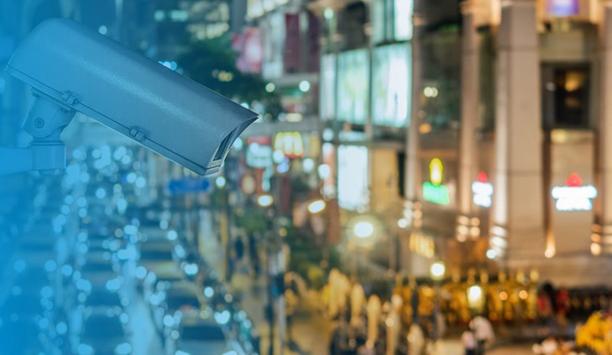
Charting the path to safe cities
Download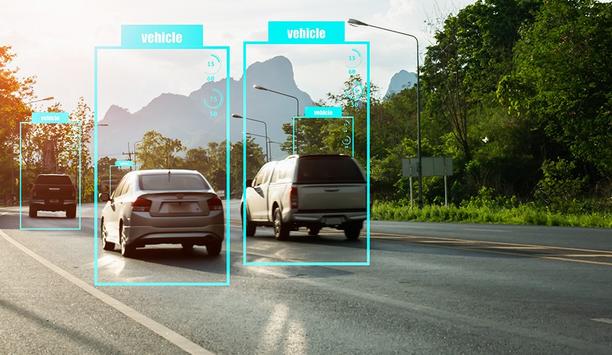
Automatic vehicle identification
Download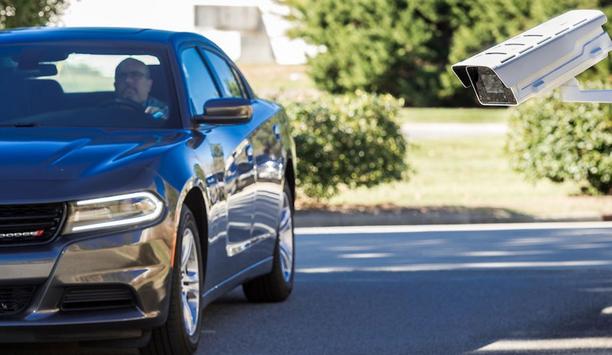
How to ramp up perimeter security with license plate reader technology
Download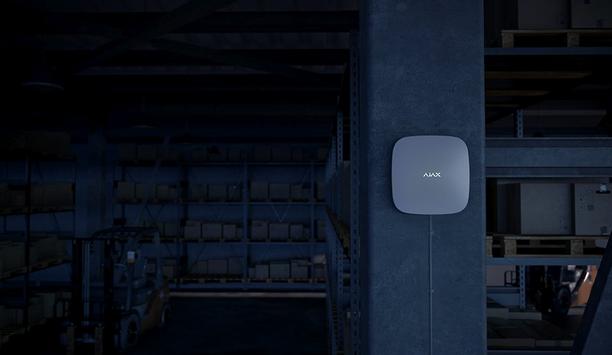
Exploring new vertical markets for professional security systems
Download
Automatic vehicle identification: State of the industry 2020
Download
Beyond security: access control for multi-tenant sites
Download
Access control & intelligent vehicle screening
Download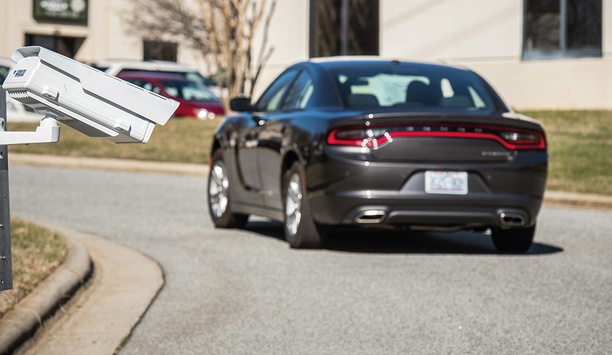
How plate reader technology increases your perimeter security
Download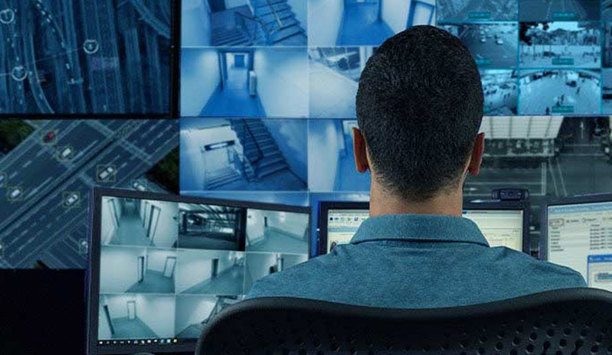
How to overcome the storage challenges of adopting surveillance AI
Download

Videos
Vehicle tracking: Manufacturers & Suppliers

Using artificial intelligence (AI) to automate physical security systems
Download
A modern guide to data loss prevention
Download
7 proven solutions for law enforcement key control and asset management
Download
The truth behind 9 mobile access myths
Download
Access control system planning phase 2
Download

